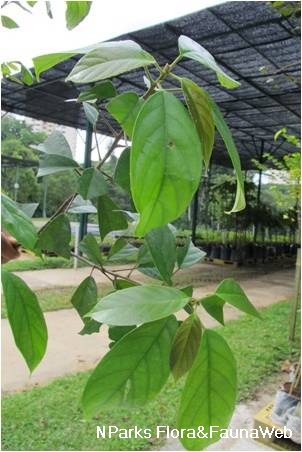
Back
Baccaurea parviflora (Müll.Arg.) Müll.Arg.
| Family Name: | Phyllanthaceae |
| Synonyms: | Pierardia parviflora Müll.Arg. |
| Common Name: | Setambun, Setamban, Wild Rambai, Rambai Hutan |
Baccaurea parviflora, also known as Setambun, is a dioecious tree that is native to Singapore. The male inflorescence occur on the whole trunk while the female inflorescence are often found at the base. Fruits are borne in strings at the base of the tree. They turn purplish black when ripe, and contain 1-3 seeds in a sour edible pulp.
Name
Classifications and Characteristics
| Plant Division | Angiosperms (Flowering Seed Plants) (Dicotyledon) |
|---|---|
| Plant Growth Form | Tree (Small (6m-15m)) |
| Lifespan (in Singapore) | Perennial |
| Mode of Nutrition | Autotrophic |
| Plant Shape | Irregular |
| Maximum Height | 15 m |
Biogeography
| Native Distribution | Myanmar, Thailand, Peninsular Malaysia, Singapore, Sumatra and Borneo. |
|---|---|
| Native Habitat | Terrestrial (Primary Rainforest, Secondary Rainforest) |
| Preferred Climate Zone | Tropical |
| Local Conservation Status | Native to Singapore (Least Concern (LC)) |
Description and Ethnobotany
| Growth Form | It is a tree, up to 15 m tall. |
|---|---|
| Foliage | Its alternate, stalked leaves have leathery leaf blades that are oval in shape, pinkish when young, up to 20 cm long and 9 cm wide. |
| Flowers | Its male and female flowers are borne on separate plants. The small flowers are yellowish-green. The scented male flowering clusters are 10-15 cm long and found upright on a ring-like burs on the trunk. The female flowering clusters are 15-30 cm long and found at the base of the trunk, with reddish stalks. |
| Fruit | Its fruits are oblong, pointed, 1.25-2.75 cm long and 1 cm wide, borne in strings at the base of the tree. The fruits are dark red to purplish black when ripe, and contain 1-3 seeds in a sour pulp. |
| Habitat | It grows in lowland forests, up to 450 m altitude. It occurs locally in Central Catchment Nature Reserve and Bukit Timah Nature Reserve. |
| Associated Fauna | Its flowers are insect-pollinated. The fruits are eaten by birds and mammals. |
| Cultivation | It can be propagated by seed. |
| Etymology | Latin Bacca, berry; Latin aurea, golden, referring to the colour of the berries; Latin parviflora means small flowers, referring to the plant’s flowers. |
| Ethnobotanical Uses | Edible Plant Parts : Edible Fruits Food (Fruit or Vegetable): The fruit is edible and sour in taste. Timber & Products: The durable and hard wood is used as a box-wood substitute, for making gardening implements and walking sticks. |
Landscaping Features
| Landscaping | It is suitable for parks and gardens. |
|---|---|
| Desirable Plant Features | Ornamental Fruits |
| Landscape Uses | General, Parks & Gardens, Small Gardens |
Fauna, Pollination and Dispersal
| Fauna Pollination Dispersal Associated Fauna | Bird-Attracting |
|---|---|
| Pollination Method(s) | Biotic (Fauna) |
| Seed or Spore Dispersal | Biotic (Fauna) |
Plant Care and Propagation
| Light Preference | Semi-Shade, Full Sun |
|---|---|
| Water Preference | Moderate Water |
| Plant Growth Rate | Moderate |
| Rootzone Tolerance | Moist Soils, Well-Drained Soils, Fertile Loamy Soils |
| Maintenance Requirements | Moderate |
| Propagation Method | Seed |
Foliar
| Foliage Retention | Evergreen |
|---|---|
| Mature Foliage Colour(s) | Green |
| Mature Foliage Texture(s) | Leathery |
| Foliar Type | Simple / Unifoliate |
| Foliar Arrangement Along Stem | Alternate |
| Foliar Attachment to Stem | Petiolate |
| Foliar Shape(s) | Non-Palm Foliage (Oval) |
| Foliar Venation | Pinnate / Net |
| Foliar Margin | Entire |
| Leaf Area Index (LAI) for Green Plot Ratio | 4.0 (Tree - Dense Canopy) |
Floral (Angiosperm)
| Flower & Plant Sexuality | Unisexual Flowers , Dioecious |
| Flower Colour(s) | Green, White, Cream / Off-White, Yellow / Golden |
|---|
| Flower Grouping | Cluster / Inflorescence |
| Flower Location | Cauliflorous |
Fruit, Seed and Spore
| Mature Fruit Colour(s) | Red, Black, Purple |
|---|---|
| Fruit Classification | Simple Fruit |
| Fruit Type | Fleshy Fruit , Non-Accessory Fruit |
Image Repository
Others
| Master ID | 1447 |
|---|---|
| Species ID | 2740 |
| Flora Disclaimer | The information in this website has been compiled from reliable sources, such as reference works on medicinal plants. It is not a substitute for medical advice or treatment and NParks does not purport to provide any medical advice. Readers should always consult his/her physician before using or consuming a plant for medicinal purposes. |









_lowres.jpg)
_lowres.jpg)
_lowres.jpg)
_lowres.jpg)



